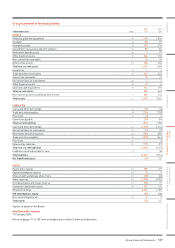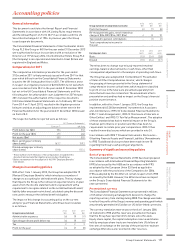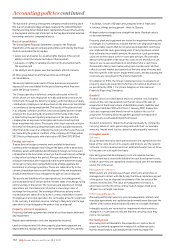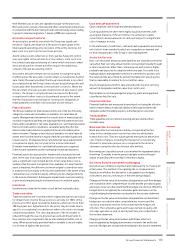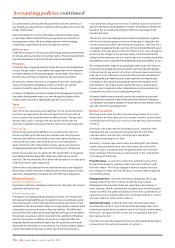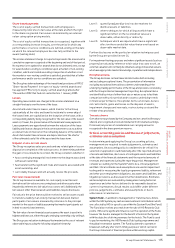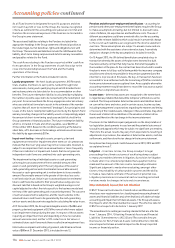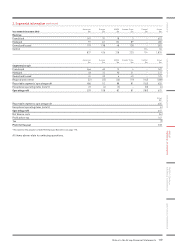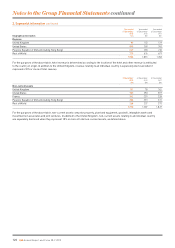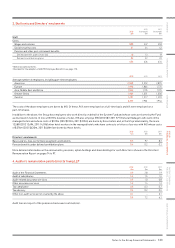Holiday Inn 2013 Annual Report Download - page 117
Download and view the complete annual report
Please find page 117 of the 2013 Holiday Inn annual report below. You can navigate through the pages in the report by either clicking on the pages listed below, or by using the keyword search tool below to find specific information within the annual report.
Share-based payments
The cost of equity-settled transactions with employees is
measured by reference to fair value at the date at which the right
to the shares is granted. Fair value is determined by an external
valuer using option pricing models.
The cost of equity-settled transactions is recognised, together with
a corresponding increase in equity, over the period in which any
performance or service conditions are fulfilled, ending on the date
on which the relevant employees become fully entitled to the
award (vesting date).
The income statement charge for a period represents the movement in
cumulative expense recognised at the beginning and end of that period.
No expense is recognised for awards that do not ultimately vest, except
for awards where vesting is conditional upon a market or non-vesting
condition, which are treated as vesting irrespective of whether or not
the market or non-vesting condition is satisfied, provided that all other
performance and/or service conditions are satisfied.
The Group has taken advantage of the transitional provisions of IFRS 2
‘Share-based Payment’ in respect of equity-settled awards and
has applied IFRS 2 only to equity-settled awards granted after
7 November 2002 that had not vested before 1 January 2005.
Leases
Operating lease rentals are charged to the income statement on a
straight-line basis over the term of the lease.
Assets held under finance leases, which transfer to the Group
substantially all the risks and benefits incidental to ownership of
the leased item, are capitalised at the inception of the lease, with a
corresponding liability being recognised for the fair value of the leased
asset or, if lower, the present value of the minimum lease payments.
Lease payments are apportioned between the reduction of the lease
liability and finance charges in the income statement so as to achieve
a constant rate of interest on the remaining balance of the liability.
Assets held under finance leases are depreciated over the shorter
of the estimated useful life of the asset and the lease term.
Disposal of non-current assets
The Group recognises sales proceeds and any related gain or loss on
disposal on completion of the sales process. In determining whether
the gain or loss should be recorded, the Group considers whether it:
• has a continuing managerial involvement to the degree associated
with asset ownership;
• has transferred the significant risks and rewards associated with
asset ownership; and
• can reliably measure and will actually receive the proceeds.
Fair value measurement
The Group measures available-for-sale equity securities and
derivatives at fair value on a recurring basis and other assets when
impaired by reference to fair value less costs to sell. Additionally, the
fair value of other financial assets and liabilities require disclosure.
Fair value is the price that would be received to sell an asset or paid
to transfer a liability in an orderly transaction between market
participants. Fair value is measured by reference to the principal
market for the asset or liability assuming that market participants act
in their economic best interests.
The fair value of a non-financial asset assumes the asset is used in its
highest and best use, either through continuing ownership or by selling it.
The Group uses valuation techniques that maximise the use of relevant
observable inputs using the following valuation hierarchy:
Level 1: quoted (unadjusted) prices in active markets for
identical assets or liabilities.
Level 2: other techniques for which all inputs which have a
significant effect on the recorded fair value are
observable, either directly or indirectly.
Level 3: techniques which use inputs which have a significant
effect on the recorded fair value that are not based on
observable market data.
Further disclosures on the particular valuation techniques used
by theGroup are provided in note 24.
For impairment testing purposes and where significant assets (such as
property) are valued by reference to fair value less costs to sell, an
external valuation will normally be obtained using professional valuers
who have appropriate market knowledge, reputation and independence.
Exceptional items
The Group discloses certain financial information both including
and excluding exceptional items. The presentation of information
excluding exceptional items allows a better understanding of the
underlying trading performance of the Group and provides consistency
with the Group’s internal management reporting. Exceptional items
are identified by virtue of either their size or nature so as to facilitate
comparison with prior periods and to assess underlying trends
in financial performance. Exceptional items can include, but are
not restricted to, gains and losses on the disposal of assets,
impairment charges and reversals, restructuring costs and the
release of tax provisions.
Treasury shares
Own shares repurchased by the Company and not cancelled (treasury
shares) are recognised at cost and deducted from retained earnings.
If reissued, any excess of consideration over carrying amount is
recognised in the share premium reserve.
Critical accounting policies and the use of judgements,
estimates and assumptions
In determining and applying the Group’s accounting policies,
management are required to make judgements, estimates and
assumptions. An accounting policy is considered to be critical if its
selection or application could materially affect the reported amounts
of assets and liabilities, disclosure of contingent assets and liabilities
at the date of the financial statements and the reported amounts of
revenues and expenses during the reporting period. Management
consider accounting for the System Fund to be a critical judgement
and that critical estimates and assumptions are used in impairment
testing and for measuring the loyalty programme liability, retirement
and other post-employment obligations, tax assets and liabilities, and
litigation provisions, as discussed in further detail below. Estimates
and assumptions are evaluated by management using historical
experience and other factors believed to be reasonable based on
current circumstances. Actual results could differ under different
policies, judgements, estimates and assumptions or due to
unforeseen circumstances.
System Fund – in addition to management or franchise fees, hotels
within the IHG System pay cash assessments and contributions which
are collected by IHG for specific use within the System Fund (the Fund).
The Fund also receives proceeds from the sale of IHG Rewards Club
points. IHG exerts significant influence over the operation of the Fund,
however the Fund is managed for the benefit of hotels in the System
with the objective of driving revenues for the hotels. The Fund is used
to pay for marketing, the IHG Rewards Club loyalty programme and
the global reservation system. The Fund is planned to operate at
breakeven with any short-term timing surplus or deficit carried in
the Group statement of financial position within working capital.
Group Financial Statements 115
OVERVIEW STRATEGIC REPORT GOVERNANCE
GROUP
FINANCIAL STATEMENTS
PARENT COMPANY
FINANCIAL STATEMENTS ADDITIONAL INFORMATION






